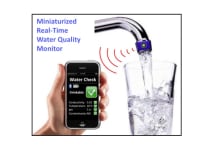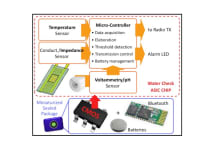Water Check is a miniaturized and low cost electronic sensor that provides continuous and real-time information about the quality of tap water. Although water is carefully monitored in main urban treatment plants, currently there is no continuous monitoring of the quality of tap water flowing at the very end of the distribution network, in every house, at every tap, just before we fill our glass. An alarm is immediately activated by Water Check in case water is polluted and not drinkable. Even in developed countries, there is high risk of accidental or intentional water contamination in urban pipes, forcing several families to buy bottled mineral water instead of drinking tap water (that is usually of good quality and much lower cost). Expensive kits for chemical water analysis at home are present on the market, but they only allow to test the quality of samples of limited significance.
Degradation of pipes and accidental pollution are likely to release metals micro and nano-particles and other contaminants, both in the form of sudden high-concentration bursts or continuous poisoning by low-concentration traces. This simple, sensitive and low cost device enables continuous monitoring, thus significantly increasing our safety related to water daily consumption.
The system is composed of a main microelectronic chip, detection electrodes in contact with water and a Bluetooth radio module. It is assembled in a sealed package (1 inch size), mounted in a threaded ring to be installed on the tap. The core of the system is the ASIC chip, expressly designed for this application. It contains several complementary sensors, monolithically integrated on the same substrate in standard CMOS technology. A temperature sensor, a conductivity and a pH sensor constitute the basic set of sensors that continuously monitor water physical parameters. Low-noise and fast analog circuits for sensor signal conditioning, analog-to-digital converters and a digital micro-controller are present for data acquisition and elaboration. Robust predictive models are implemented in the firmware, to track the measured parameters and detect if safety thresholds are crossed.
Further bio-chemical analysis can be envisioned by enhancing the impedance sensor with arrays of selective biochemical receptors (antibodies, enzymes, DNA) to specifically detect the presence of pathogenic micro-organisms. A pulsed led indicates if water is not drinkable, while the full analysis reports is wireless transmitted to an interrogating smart phone.
Power is supplied by small batteries, integrated in the sealed package. In case very low power consumption is achieved (sub-mW), the integration of a MEMS energy harvesting device can be envisioned, in order to avoid batteries and recover energy directly from the fluid motion.
The potential market is huge, as every kitchen tap could be equipped with Water Check. Simplified versions of the device could find of course widespread diffusion also in underdeveloped countries, mounted in mugs and in water storing reservoirs. Mass production volumes (millions dies per year), typical of integrated circuits, will allow to cut the cost of a single item, below 10$, turning it into a pervasive (even disposable) safety gadget.
Like this entry?
-
About the Entrant
- Name:Marco Carminati
- Type of entry:individual
- Software used for this entry:MS Office, Orcad and Matlab
- Patent status:none





